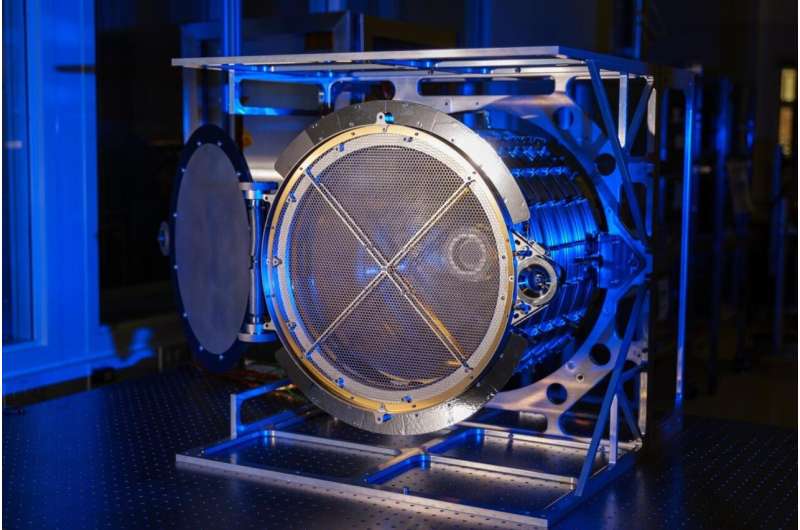This article has been reviewed according to Science X's editorial process and policies. Editors have highlighted the following attributes while ensuring the content's credibility:
fact-checked
trusted source
proofread
New instrument to capture stardust as part of NASA mission

Scientists and engineers at the CU Boulder will soon take part in an effort to collect a bit of stardust—the tiny bits of matter that flow through the Milky Way Galaxy and were once the initial building blocks of our solar system.
The pursuit is part of NASA's Interstellar Mapping and Acceleration Probe (IMAP) mission to explore our solar neighborhood—decoding the messages in particles from the sun and beyond our cosmic shield. Since 2018, a team from the Laboratory for Atmospheric and Space Physics (LASP) at CU Boulder has led the development of one of the mission's 10 scientific instruments.
This week, the team carefully loaded the instrument, known as the Interstellar Dust Experiment (IDEX), onto a delivery truck. The instrument, which is shaped like a large drum and weighs 47 pounds, will travel to the Johns Hopkins University Applied Physics Laboratory in Maryland. There, engineers will begin the process of installing IDEX onto the IMAP spacecraft.
IDEX is the first IMAP instrument to arrive in Maryland. Over the two-year mission, IDEX will detect and analyze in great detail the composition of hundreds of interstellar dust particles. These particles flow into our solar system from the vast expanses of space between stars, or the interstellar medium. IDEX will also detect thousands of interplanetary dust particles shed from comets and asteroids.
Interstellar grains are spread so thin that the instrument may only collect a few hundred of them during its lifetime. But each small speck of interstellar dust holds a treasure trove of information.
"These dust particles were born in supernova explosions, most of them have been altered as they traveled in interstellar space, but they're still the closest material we have for understanding the original building blocks of the solar system," said Mihály Horányi, principal investigator for IDEX and a professor in LASP and the Department of Physics at CU Boulder. "Detecting and analyzing them in space opens a new window to the universe."
IMAP, which is led by Princeton University, is slated to launch in spring 2025 and will journey roughly 1 million miles to a point in space between Earth and the sun called Lagrange Point 1.
During the mission, IDEX will open its roughly 20-inch-wide aperture to capture dust zooming by, a bit like a humpback whale scooping up krill. The instrument will record how fast these particles are traveling and from where and what they're made of.
Raquel Arens, who works on mission operations for IDEX, explained that the instrument is the result of years of work from a team of professionals and students at LASP—including a lot of late nights and early mornings.
"What we as a team and LASP have accomplished is amazing," said Arens, a professional research assistant at LASP.
Fast and furious
Dan Baker, director of LASP, added that the institute has a long legacy of taking a magnifying glass to the universe's often-overlooked dust. A team at LASP previously designed and built a similar instrument called the SUrface Dust Analyzer (SUDA). SUDA is part of NASA's Europa Clipper Mission, which is scheduled launch for Jupiter's moon Europa later this year. LASP's Student Dust Counter launched on the New Horizons mission in 2006 and is now exploring the outskirts of our solar system.
"It has been one of the major achievements of LASP to pursue cosmic dust research," Baker said. "For some two decades the LASP team has refined and advanced the detection techniques to allow truly amazing measurements that revolutionize our understanding of the origin and evolution of our solar system and the vast cosmos beyond."
Trapping dust in space is no easy feat, said Scott Tucker, IDEX project manager. Because interstellar dust particles are so rare, he and his colleagues had to make the instrument roughly two-and-a-half times bigger than SUDA—the bigger the mouth, the more particles you can catch.
Each grain of dust, which will likely be rich in the elements silicon and carbon, may only measure a few millionths of an inch wide. But some will also be traveling at speeds of well over 100,000 miles per hour.
As these grains crash into the back of IDEX, they will instantly vaporize into a cloud of ions, which the instrument will then collect and analyze.
"The main challenge with IDEX has been what engineers call 'dynamic range,'" Tucker said. "We've got to take both really fast and large particles and smaller and slower particles and measure them with the same instrument."
To date, he added, scientists have only been able to capture and study a few dozen grains of interstellar dust, making each new find by IDEX precious.
"They're little packets of information from long ago and far, far away," Tucker said.
Bon voyage
He added that IDEX wouldn't have made it out of Colorado, let alone into space, without contributions from students and early-career professionals.
Arens is one of those budding researchers. She earned her undergraduate degree in astrophysics from CU Boulder in 2020 and joined LASP in 2023. She made sure that IDEX was operating correctly while engineers ran it through a barrage of tests. That included shooting tiny pieces of minerals that represent interstellar matter at the instrument using a machine on campus called a dust accelerator.
She is also one of 87 people who will be traveling, ceremoniously, to space alongside IDEX—the instrument carries a plaque engraved with the names of many of the team members who worked on it over the years.
"It's astounding to watch all of these engineers work together, work late hours, figure out problem and continuously keep moving forward with a positive attitude," Arens said.
Provided by University of Colorado at Boulder





















